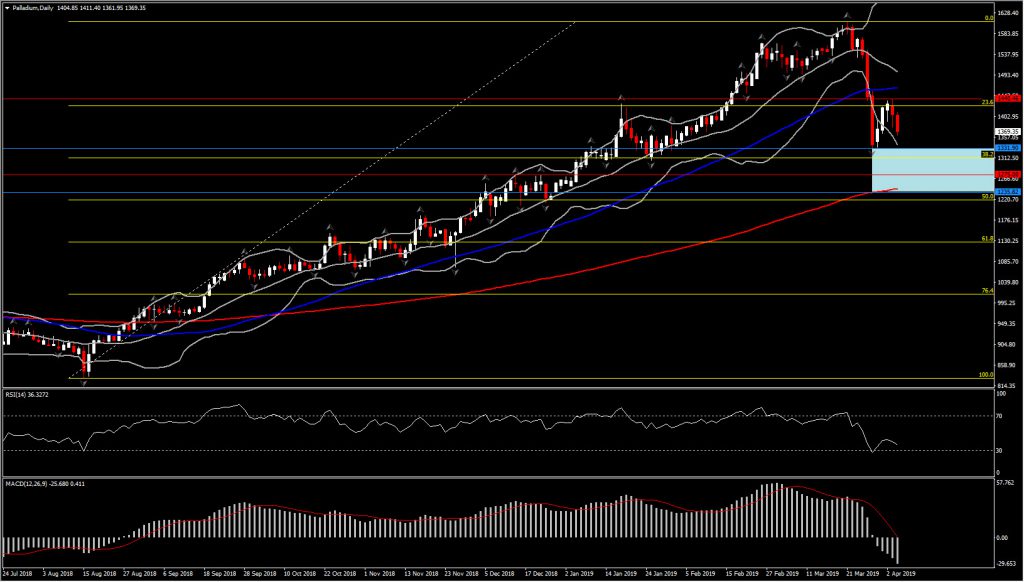Palladium, Daily & Weekly
Spot palladium tumbled by more than 17% from record highs at $1,609.85 at the end of March, with the main catalyst of this drift possibly being the closing of positions as the end the month and the end of quarter (i.e. end of the contract) came. The plummet was the biggest drop seen in the past 2 years, raising concerns regarding a possible bubble burst of the $1,116 rally since 2016. This amounts to a 234% rise.
As Commerzbank stated: “In our opinion, a correction of the palladium price was long overdue. It is not yet possible to say whether yesterday’s plunge was the bursting of a bubble; for this to be the case, the price would need to fall even more sharply or further.”
Indeed, technically speaking, we cannot claim that the bubble has burst, as the precious metal has retraced less than 23.6% of 3-year gains and less than 38.2% of 2018 gains. Meanwhile, it holds above the 20-week SMA, which has been providing a strong Support area for the asset the past three quarters.
Theoretically speaking however, Palladium is strongly positive correlated with the car industry as it finds 80% of its demand from gasoline autocars. The source of Palladium’s performance the last decade, though, was and still is the global supply deficit, fired by the car industry demand. Considering only the 2017 supply, the deficit reached 801K ounces.
Despite the latest decline in Palladium’s prices, it is unlikely that the demand for palladium will change significantly the next few years. This could be explained by the tighter emission standards, as despite the overall economic slowdown, the auto sales slowdown in China (due to tax cuts) and US, the higher recycling volume, and the high price of palladium, car-makers must meet emission standards. Hence they are quite “forced” to use palladium, as it is the metal used in catalyst converters to reduce emissions from gasoline engines.
In Europe on the other hand, the swing from diesel engines has hit European producers and as a consequence platinum price as well, which was the most preferable metal for reducing emissions in diesel engines. This balanced the risks stated above, for Palladium’s price, as diesel engines are “undesirable”.
The expensive palladium and unwelcome platinum could eventually push manufacturers to turn to potential PGM-free engines (PGM stands for Platinum Group Metals). However this would take time. A potential approach for manufacturers could be to substitute palladium for platinum on engines other than diesel ones. However this is a scenario has not be accomplished yet and seems inevitable to happen for now.
So far, the legislation and the taxation for diesel engines, but also the general tighter emission standards, have boosted the substitution of diesel engines into alternative engines, such as electric, hybrid and petrol which all require the use of more palladium. Gasoline vehicles are expected to maintain a majority market share to 2025 and to increase in absolute numbers including gasoline hybrids. These factors could keep palladium demand rising, unscathed from the economic slowdown and the higher recycling volume.
Meanwhile, in China, the world’s largest consumer, Morgan Stanley reported that new legislation will be applied from 2020 which will require 30% more PGMs on each vehicle. This is another factor that is likely to keep demand high.
As Norilsk Nickel Group, one of the largest palladium mining company stated: “The demand for palladium is growing.” “Per unit PGM consumption in hybrid cars is higher than in traditional vehicles with the same ICE volume; accordingly, we expect palladium consumption to increase by 3 mln oz by 2025. “
Additionally, according to research from BASF, the world’s leading supplier of catalysts, demand for palladium in China is expected to grow from 2.332 million ounces to 3.429 million ounces by 2022.
As the supply deficit is more in favour of palladium than platinum or any other PGM metal, the palladium price is not expected to extend the sell off for long. Currently, palladium is accelerating lower again, after the small rebound from last week’s low, at 1,331.90. Having met the Resistance area at the edge of the upper weekly Bollinger Bands pattern at 1609.85 on March 21, the sharp pullback seems to be a correction of this long term rally.
Looking at the technical indicators, the longterm outlook keep engrossing by a strongly positive sentiment. The medium term however and more precisely the daily indicators, turn to a decreasing momentum, signalling a possible extension of the latest drift. The MACD lines turned negative, with lower Bollinger Bands and RSI pointing downwards.
A closing breakout below 1-week Support at 1,331.9 could push palladium to December 2018 and January 2019 levels. The next Support is at 1,275, which is the mid of 38.2%-50.0% Fibonacci retracement of the August 2018-March 2019 upleg. Further losses would open the way to a significant area for the longterm outlook as it is a break of this area that could confirm a bubble burst and could open the way to 1-year lows. This area is placed between 200-day EMA and the 50% fib level, i.e. 1,220-1,235 area.
On the flipside, Resistance comes between the latest peak and the 50-day EMA, at 1,440-1,465. The breach and break the latter could retest the record peak at 1,619.
Click here to access the Economic Calendar
Andria Pichidi
Market Analyst
Disclaimer: This material is provided as a general marketing communication for information purposes only and does not constitute an independent investment research. Nothing in this communication contains, or should be considered as containing, an investment advice or an investment recommendation or a solicitation for the purpose of buying or selling of any financial instrument. All information provided is gathered from reputable sources and any information containing an indication of past performance is not a guarantee or reliable indicator of future performance. Users acknowledge that any investment in FX and CFDs products is characterized by a certain degree of uncertainty and that any investment of this nature involves a high level of risk for which the users are solely responsible and liable. We assume no liability for any loss arising from any investment made based on the information provided in this communication. This communication must not be reproduced or further distributed without our prior written permission.





















